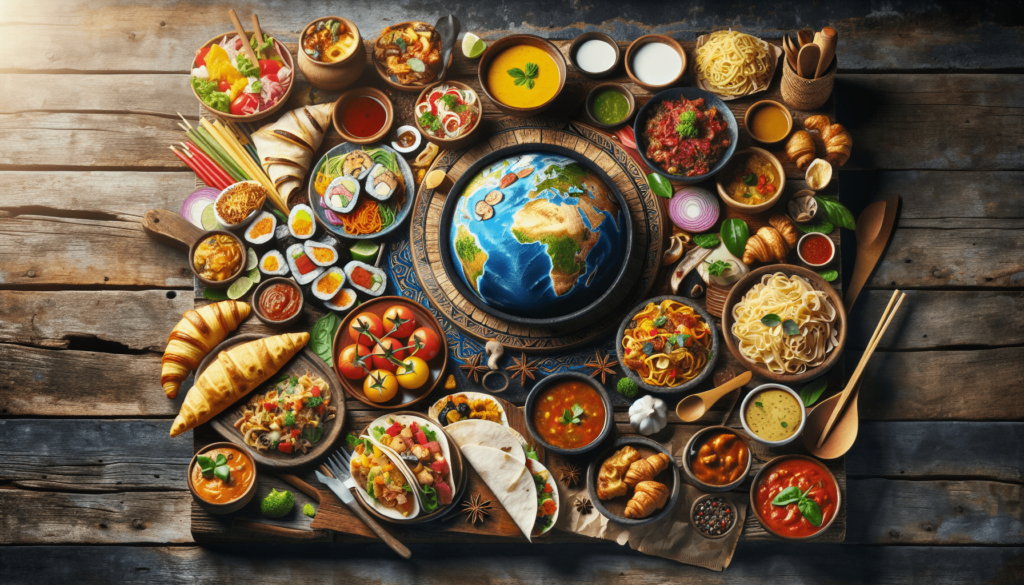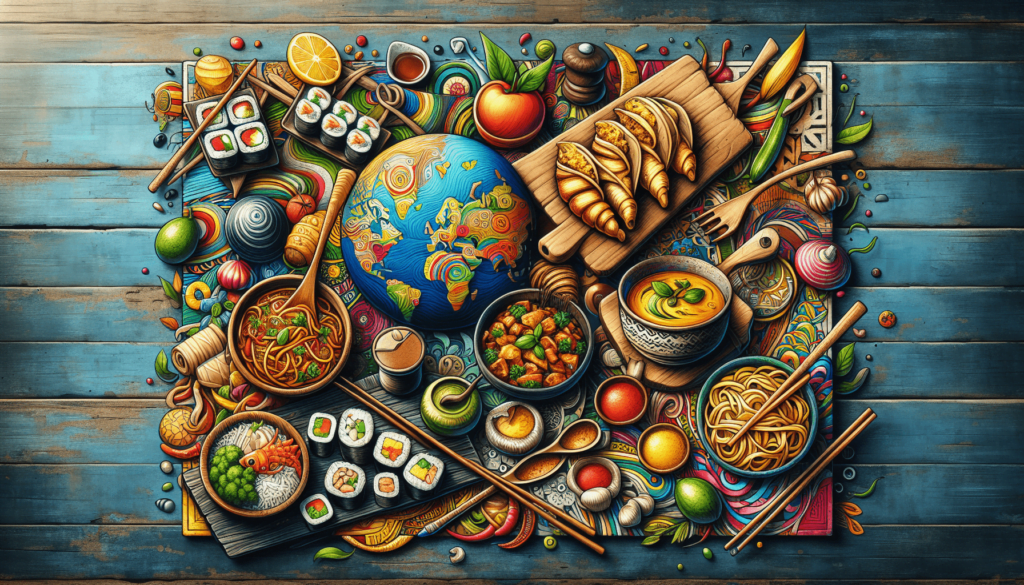“Exploring global cuisines: Embark on Food Trails Around the World” invites you to discover the rich tapestry of flavors and traditions that span across continents. As you delve into this article, you’ll journey through the historical roots of diverse culinary practices, uncovering the influences that have shaped how we dine today. You’ll also explore current trends reshaping the global food scene and learn about key concepts that make each cuisine unique. With vivid examples, balanced perspectives, and eye-opening predictions, this guide uncovers not just the foods we eat but the stories they tell. Whether you’re a seasoned foodie or a curious traveler, prepare to be captivated by the world’s gastronomic wonders.
Table of Contents
Exploring Global Cuisines: Embark on Food Trails Around the World
Have you ever wondered how diverse and flavorful dishes from around the world can bring new excitement to your taste buds?
Overview
In an increasingly interconnected world, exploring global cuisines has become more than just an adventure for your palate; it’s a journey through culture, history, and tradition. Timely and relevant, this topic invites you to step out of your culinary comfort zone and to embrace the rich tapestry of tastes that different cultures offer.
Thesis Statement
This article delves into the fascinating world of global cuisines, showcasing how food trails around the world can enrich your culinary skills, deepen your cultural appreciation, and offer a more comprehensive understanding of our global community.

This image is property of images.pexels.com.
Historical Context
The Evolution of Global Cuisines
The history of global cuisine is as varied and rich as the dishes themselves. From the ancient Silk Road to colonization and modern globalization, food has always been a central aspect of cultural exchange and influence.
Ancient Culinary Routes
One of the most famous historical food trails is the Silk Road, which connected East Asia with the Mediterranean. Spices, tea, and silk were traded along this route, profoundly influencing the cuisines of the regions it touched.
Current Trends
The Rise of Fusion Cuisine
In today’s culinary landscape, fusion food is all the rage. Chefs combine elements from different culinary traditions to create exciting and novel dishes, like Korean tacos or sushi burritos, pushing the boundaries of taste and texture.
Farm-to-Table Movement
The farm-to-table movement emphasizes local sourcing and sustainability. This trend is not only more environmentally friendly but also encourages the exploration of regional flavors and traditional cooking methods.

This image is property of images.pexels.com.
Key Concepts and Definitions
Food Trails
Food trails are journeys taken to explore foods in their native regions. These can include guided tours of markets, cooking classes, and visits to farms and artisanal producers.
Cultural Relevance
Cuisine is deeply tied to cultural identity and heritage. Exploring different cuisines can offer insights into the values, traditions, and historical events that have shaped a particular culture.
Detailed Exploration
Asian Culinary Masters
Japanese Cuisine: More than Sushi
Japan offers a cuisine rich in subtlety and refinement beyond just sushi and sashimi. From Kaiseki, a multi-course dinner rooted in ancient court traditions, to Shabu-Shabu hot pots, Japanese food emphasizes quality, freshness, and seasonality.
Thai Food: Aromatic and Spicy
Thai cuisine is known for its balanced flavors—sweet, sour, salty, and spicy. Dishes like Tom Yum Goong (spicy shrimp soup) and Pad Thai are not only delicious but also offer a glimpse into Thailand’s intricate spice culture.
European Flavors
French Cuisine: The Pinnacle of Culinary Art
French cuisine has long been considered the epitome of fine dining. From buttery croissants to rich coq au vin, French meals are a celebration of technique and terroir (the unique characteristics imparted by a region’s climate, soil, and terrain).
Italian Cuisine: The Comfort of Home
Italian food is loved worldwide for its simplicity and taste. From the fresh pastas of Tuscany to the pizzas of Naples, Italian cuisine focuses on high-quality ingredients and straightforward preparation methods.
African and Middle Eastern Delicacies
Moroccan Spices
Moroccan cuisine is a melting pot of Arab, Berber, Andalusian, and Mediterranean influences. Dishes like Tagine, a slow-cooked savory stew, and Couscous offer a unique blend of spices such as cumin, cinnamon, and saffron.
Persian Flavors
Persian cuisine is notable for its use of herbs and fruits in savory dishes. Polo (rice dishes) and Khoresht (stews) often incorporate ingredients like pomegranates, walnuts, and dried lime for a unique and nuanced flavor profile.
The Americas’ Culinary Tapestry
Mexican Street Food
Street food is an integral part of Mexican culinary culture. Tacos, tamales, and churros offer a quick, delicious, and affordable way to experience the local cuisine.
Brazilian Feijoada
Feijoada, a hearty black bean stew with pork, is a beloved dish in Brazil. It’s usually served with rice, collard greens, and orange slices, providing a well-rounded meal that showcases traditional Brazilian flavors.

This image is property of images.pexels.com.
Case Studies
Spain’s Tapas Culture
In Spain, tapas are not just small plates; they’re a lifestyle. Visiting a tapas bar in Madrid or Barcelona means enjoying a variety of dishes like Patatas Bravas, Jamón Ibérico, and Gambas al Ajillo, enriching your understanding of Spanish social culture.
Indian Thali: A Culinary Journey in a Single Plate
An Indian Thali offers a bit of everything—from dal (lentils) and sabzi (vegetables) to rotis and rice, accompanied by pickles and chutneys. It showcases the rich culinary diversity spanning the Indian subcontinent.
Comparison of Different Perspectives
When it comes to global cuisines, purists often advocate for traditional preparation methods and ingredients, while modernists are open to innovation and fusion. Both perspectives offer valuable insights into culinary arts, with traditionalists preserving the cultural heritage and modernists pushing the boundaries of culinary creativity.
Traditional vs. Modern Approaches
- Traditional: Emphasis on authenticity, preserving culinary techniques passed down through generations.
- Modern: Focus on creativity and innovation, often integrating elements from multiple cuisines for a unique experience.

Impact Assessment
Different culinary approaches have varying impacts on our dining experiences. Traditional methods offer a sense of authenticity and cultural immersion, while modern approaches bring excitement and novelty to the table. Both, however, contribute significantly to the richness of global cuisine.
Future Directions and Implications
Predictions
As our world becomes more interconnected, expect even more exciting developments in the culinary world. Technologies like 3D food printing and AI-generated recipes could revolutionize how we create and consume food.
Implications
From a societal standpoint, an increased openness to global cuisines can foster greater cultural understanding and appreciation. In the industry, restaurants and chefs who embrace global influences will continue to thrive and innovate.

Conclusion
Recap
Exploring global cuisines isn’t just about tasting new foods. It’s an enriching educational experience that offers insights into different cultures, histories, and societal values. From the enticing spices of Morocco to the comforting pastas of Italy, each cuisine tells a unique story.
Final Thought
So the next time you sit down to a meal, think about the journey behind each bite—the history, the culture, and the potential for new culinary adventures. What will you explore next?
Engagement
Feel free to share your own food journeys, comment on your favorite cuisines, and explore more resources to deepen your understanding of global culinary practices.
Credible Sources
- Books:
- “The Silk Roads: A New History of the World” by Peter Frankopan
- “Larousse Gastronomique” by Prosper Montagné
- Websites:
- Academic Papers:
- Smith, Andrew F. “The Oxford Companion to American Food and Drink.”
- Sanchez, Susan Herlin. “Food Routes: Growing Bananas in Iceland and Other Tales from the Logistics of Eating.”
